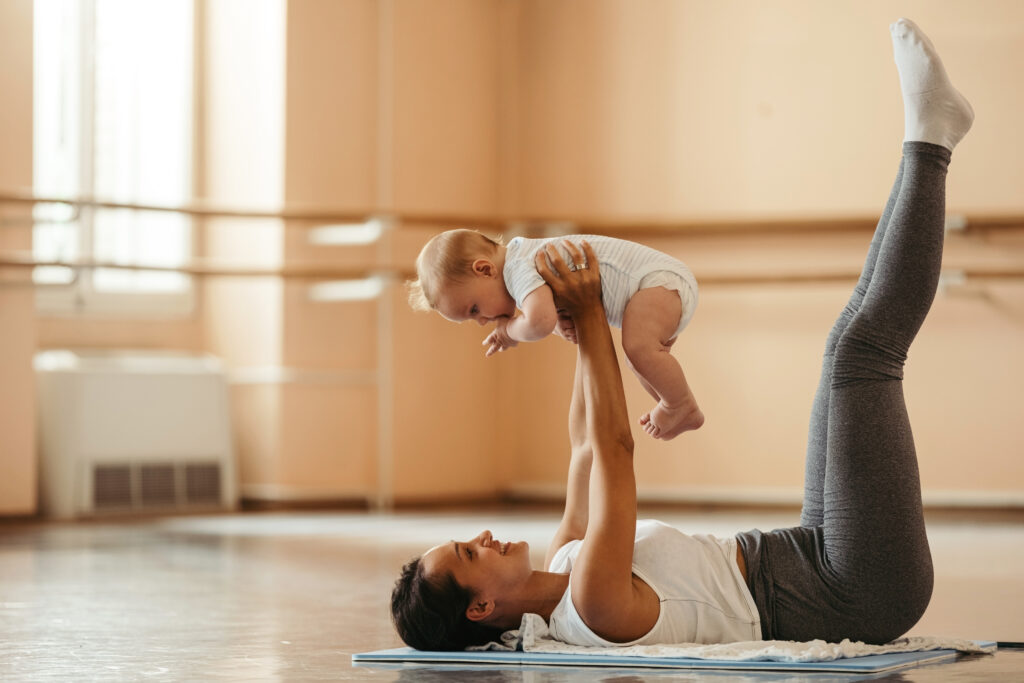
Categories
When Can I Return to Exercise Post Pregnancy?
A question I’ve often been asked by women during their postpartum period is, “When can I return to exercise post pregnancy?” This is a fantastic question, and it’s wonderful to hear that so many postpartum women are eager to return to exercise. However, it’s important to appreciate the significant physical and hormonal changes your body has undergone – after all, you’ve grown a human! Congratulations! The female body is truly incredible, and acknowledging its remarkable journey is the first step towards a healthy recovery.
Our priority initially should be rest and recovery, which are essential for your long-term health and wellbeing. There are several factors to consider before reintroducing exercise. For instance, sleep deprivation can increase both stress levels and the risk of injury. Additionally, breastfeeding continues to alter your hormonal environment and can affect joint laxity. Your pre-pregnancy activity and training experience also play a role in how and when you should return to exercise.
Despite these considerations, we all know that exercise has immense benefits for both physical and mental health. Therefore, it’s a careful balancing act to ensure your return to exercise is safe and effective.
Let’s break down this journey into stages to help you navigate this transition smoothly.

Stage 1: Weeks 0 – 6 – Focus on Recovery
The main focus during the first six weeks postpartum is recovery. Your activity levels should be kept minimal, around a 2 out of 10 effort, to maximize the healing process. This period is crucial for your body to recover from childbirth. However, when you feel ready, you can gradually reintroduce light walking and mobility exercises to help relieve tension. Simple exercises like thread the needle, cat-cow, Hip CARs can be beneficial. It’s also a good time to start reconnecting diaphragmatic breathing with pelvic floor function, often this connection is compromised prenatally and postpartum so it’s important to re-establish the fundamentals – inhaling wide into your ribcage and relax the pelvic floor and engage the pelvic floor as you exhale.
Stage 2: Week 6 – The Six-Week Check-Up
In week six, you will have a check-up with your GP. Hopefully, you will get the all-clear to return to exercise – fingers crossed! In addition to this check-up, we highly recommend a Mummy MOT or a Women’s Health physio appointment for a thorough assessment. This additional evaluation ensures that your body is ready to handle increased activity levels, assesses posture, aids pelvic floor connectivity and helps identify any underlying issues that might need attention.
Stage 3: Weeks 7-12 – Gradual Return to Low-Impact Exercise
Provided you have the green light from your healthcare professional and are not experiencing any symptoms, it is safe to return to low-impact exercise during weeks 7-12. This includes cardiovascular activities such as swimming and cycling, as well as low-intensity resistance training. During these weeks, it’s essential to adopt a gradual approach when progressing from low to moderate intensity activities. This careful progression helps prevent injury and allows your body to adapt to the increasing demands of exercise.
Stage 4: Week 12 and Beyond – Slowly Reintroducing Higher Impact Exercise
Having steadily increased your activity in the previous stages, now is the opportunity to slowly begin higher-impact exercises. From week 12 onwards, activities such as running, jumping, and various sports can be gradually reintroduced. Alongside these activities, continued pelvic floor work and mobility exercises remain crucial. These exercises support your body’s overall stability and help maintain the strength you’ve built during the earlier stages.
Listening to Your Body
Throughout all four stages, it is imperative to listen to your body. You know your body better than anyone else. Any signs of incontinence, pressure, heaviness, or pain in the pelvic area are signals that you need to reduce the intensity of your activities. If you experience any of these symptoms, please seek guidance from a qualified professional. They can help you adjust your exercise routine to ensure it aligns with your body’s current needs.
Individual Differences
Every woman, every pregnancy, and every postpartum experience is different. Therefore, we encourage a gradual approach to your return to exercise. You’re already doing an amazing job by prioritizing your health and taking steps to ensure a safe return to fitness.
Embracing the Journey
Returning to exercise post-pregnancy is not a one-size-fits-all journey. It requires patience, self-compassion, and a keen awareness of your body’s signals. Remember, the goal is not just to return to your pre-pregnancy fitness levels but to support your overall well-being and health as a new mother and beyond. This journey is unique for each woman, and embracing this uniqueness is key to a successful and fulfilling postpartum fitness experience.
Additional Tips for a Smooth Transition
- Stay Hydrated: Proper hydration is crucial, especially if you are breastfeeding. Ensure you are drinking enough water throughout the day.
- Balanced Nutrition: Focus on a balanced diet rich in nutrients to support your recovery and energy levels.
- Adequate Sleep: Although challenging with a newborn, try to rest whenever possible. Sleep is vital for recovery and overall health.
- Support System: Surround yourself with a supportive network of family, friends, or a fitness community. They can provide encouragement and motivation.
- Professional Guidance: Don’t hesitate to seek help from fitness professionals who specialise in postpartum exercise. They can tailor workouts to your specific needs and goals.
Common Questions and Concerns
1. When can I start doing core exercises?
Breathwork and pelvic floor engagement can be reintroduced when you feel ready. Core exercises can be reintroduced gradually after your six-week check-up. Start with foundational exercises like pelvic tilts, glute bridges and heel slides. Avoid more complex and demanding abdominal exercises like crunches or sit-ups or prolonged plank variations until you have built a solid foundation.
2. Is it safe to lift weights postpartum?
Yes, it is safe to lift weights postpartum, but start with a lower intensity and focus on your technique. It’s beneficial to work with a fitness professional to ensure you are lifting safely and effectively.
3. What is a Mummy MOT?
A Mummy MOT is a specialised postnatal check-up for women after both vaginal and C-section births. It evaluates the recovery of your posture, pelvic floor muscles, and abdominal muscles following childbirth. Your Mummy MOT practitioner will offer gentle exercises and treatments to aid your recovery and help you achieve your fitness goals.
4. Can I do high-intensity interval training (HIIT)?
HIIT can be reintroduced gradually after 12 weeks, depending on your stage of recovery and training experience. Start with low-intensity low-impact intervals and gradually increase the intensity. Pay attention to how your body responds and adjust accordingly.
5. What if I had a C-section?
If you had a C-section, your recovery might take longer. It’s crucial to follow your doctor’s advice and give your body the necessary time to heal. Gentle walking and pelvic floor exercises are usually recommended initially, with a gradual return to other activities as you feel ready.
Celebrating Milestones
Remember to celebrate the small milestones along your postpartum fitness journey. Every step, no matter how small, is a testament to your strength and dedication. Whether it’s your first postpartum workout, a new personal best, or simply feeling more energised, acknowledging these achievements can boost your motivation and confidence.
The Importance of Mental Health
Physical exercise is just one aspect of postpartum recovery. Mental health is equally important. Exercise can significantly improve your mood and mental well-being by releasing endorphins and reducing stress. However, if you’re feeling overwhelmed or experiencing postpartum depression, it’s crucial to seek support from mental health professionals.
Final Thoughts
Returning to exercise after pregnancy is a journey that requires time, patience, and a deep understanding of your body’s needs. By following a gradual approach and listening to your body, you can safely and effectively return to exercise. Celebrate your progress, seek professional guidance when needed, and most importantly, be kind to yourself. Your body has achieved something remarkable, and it deserves the care and attention needed to recover and thrive.
You’re doing an amazing job already, and with the right approach, you’ll find your way back to the activities you love, stronger and more resilient than ever.
